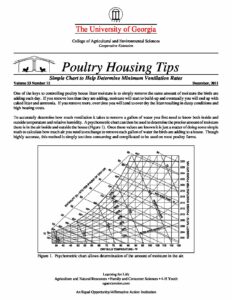One of the keys to controlling poultry house litter moisture is to simply remove the same amount of moisture the birds are adding each day. If you remove less than they are adding, moisture will start to build-up and eventually you will end up with caked litter and ammonia. If you remove more, overtime you will tend to over dry the litter resulting in dusty conditions and high heating costs.
To accurately determine how much ventilation it takes to remove a gallon of water you first ne...ed to know both inside and outside temperature and relative humidity. A psychometric chart can then be used to determine the precise amount of moisture there is in the air inside and outside the house (Figure 1). Once these values are known it is just a matter of doing some simple math to calculate how much air you need to exchange to remove each gallon of water the birds are adding a house. Though highly accurate, this method is simply too time consuming and complicated to be used on most poultry farms.
The calculation process can be dramatically simplified if a couple assumptions are made. First, since we are primarily concerned with moisture control during cold weather, it is best to assume fairly typical wintertime conditions; for instance, 30oF and 50% Rh. Second, we may assume an inside relative humidity of 60%, which is generally recommended for optimal bird health. Last, but not least we need to assume that roughly 80% of the water the birds drink is put back into the litter and air in a house. With these three assumptions a simple table can be developed to determine the runtime of two or four 36" fans (9,000 cfm per fan) to remove the moisture the birds add to a house for every 100 gallons consumed (Table 1)......
Details
| Year | Volume | Number | Categories |
|---|---|---|---|
| 2011 | 23 | 12 |

